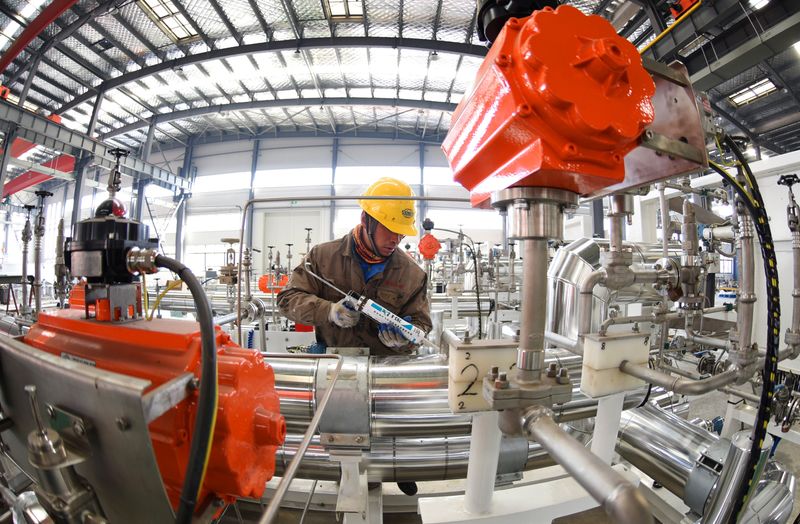By Qiaoyi Li, Joe Cash and Liangping Gao
BEIJING (Reuters) -China's industrial profits fell again in October but less sharply than the previous month as deflation pressures dragged while demand remained soft in the crisis-hit $19 trillion economy.
Fresh headwinds from additional U.S. tariffs could also threaten China's industrial sector next year, reducing export earnings.
The sprawling sector, which includes mining, processing and manufacturing companies, has struggled to stay profitable in the face of feeble domestic demand hit by a years-long property crisis, unemployment and rising trade tensions.
Policymakers have vowed to meet the government's gross domestic product growth target of around 5% this year even as U.S. President-elect Donald Trump pledges to slap more tariffs on China-made goods.
Industrial profits in October fell 10% year on year, better than a 27.1% slump in September though earnings slid 4.3% in the first 10 months versus a 3.5% decline in January-September, National Bureau of Statistics (NBS) data showed on Wednesday.
Profits in most industries improved compared with the previous month, with new drivers such as equipment and high-tech manufacturing playing a strong supporting role, NBS statistician Yu Weining said in an accompanying statement.
But some private-sector economists attributed the October improvement partly to the effect of a low base from a year earlier. Industrial profits in October 2023 grew 2.7%, easing from double-digit gains in August and September last year.
"For the October monthly data alone, the year-on-year level has a lot of noise due to base effects, and the difference can largely be attributed to this," said Lynn Song, chief economist for Greater China at ING.
"Overall, profits are still under some pressure this year as the 4.3% year-on-year decline year-to-date shows, though there is hope that as more policy easing starts to come through, the operating environment will become more favourable next year."
DEFLATIONARY PRESSURES
Separate economic indicators earlier this month pointed to broadly soft demand, with consumer prices at their weakest in four months while industrial output continued to trend downward and new home prices fell at their fastest pace in nine years.
Data earlier this month showed producer prices fell 2.9% on year in October, deeper than the 2.8% drop in the previous month and worse than an expected 2.5% decline. It marked the biggest drop in 11 months.
Factory-gate deflation deepened in the petroleum and natural gas extraction, oil and coal processing, chemical products manufacturing and auto manufacturing sectors.
"Raw materials manufacturing and consumer goods manufacturing profits continue to face pressure to fall further," warned Ma Hong, senior analyst at GDDCE Research Institution.
"Looking ahead to November, in view of the PPI which remains in the negative range, the price of raw materials represented by coal is under pressure, and industrial enterprise profit margins are still in a slow downward trend."
Industrial profit numbers cover firms with annual revenues of at least 20 million yuan ($2.8 million) from their main operations.
China's $1.4 trillion local debt package unveiled earlier in November fell short of expectations for strong stimulus to boost consumption, meaning investors are still waiting for a more direct fiscal bazooka.
China's export earnings will also be squeezed by U.S. tariffs, hammering manufacturers. Trump could impose 40% tariffs on imports from China, a Reuters poll of economists showed.
If tariffs are gradually increased to 40% and not all at once, expedited shipments ahead of new tariffs could help offset the impact of subsequently higher levies, resulting in a 2025 export decline of 1.7%, according to Minsheng.

If only an additional 10% tariffs are imposed, China's 2025 export growth could come in at 0.2%, the Chinese securities firm said.
($1 = 7.2567 Chinese yuan)